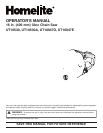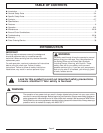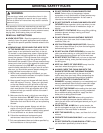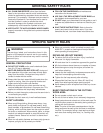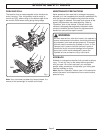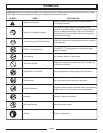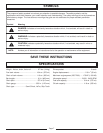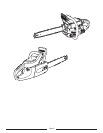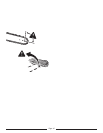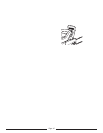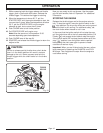
Page 3
WARNING:
The warnings, labels, and instructions found in this
section of the operator's manual are for your safety.
Failure to follow all instructions may result in serious
personal injury.
Safe operation of this tool requires that you read and
understand this operator's manual and all labels affixed to
the tool. Safety is a combination of using common sense,
staying alert, and knowing how your saw works.
READ ALL INSTRUCTIONS
KNOW YOUR TOOL. Read the operator's manual
carefully. Learn the saw's applications and limitations
as well as the specific potential hazards related to this
tool.
KICKBACK MAY OCCUR WHEN THE NOSE OR TIP
OF THE GUIDE BAR touches an object or when the
wood closes in and pinches the saw chain in the cut.
Tip contact in some cases may cause a lightning-fast
reverse reaction kicking the guide bar up and back
toward the operator. Pinching the saw chain along the
top of the guide bar may push the guide bar rapidly
back toward the operator. Either of these reactions may
cause you to lose control of the saw which could result
in serious personal injury. DO NOT rely exclusively
upon the safety devices built into your saw. As a chain
saw user, you should take several steps to keep your
cutting jobs free from accident or injury.
1. With a basic understanding of kickback, you can
reduce or eliminate the element of surprise. Sudden
surprise contributes to accidents.
2. Keep a good firm grip on the saw with both hands
when the engine is running. Place your right hand
on the rear handle and your left hand on the front
handle with your thumbs and fingers encircling the
chain saw handles. A firm grip together with a stiff
left arm will help you maintain control of the saw if
kickback occurs.
3. Make sure that the area in which you are cutting is
free from obstructions. DO NOT let the nose of the
guide bar contact a log, branch, fence, or any other
obstruction that could be hit while you are operating
the saw.
4. Cut at high engine speeds. Always cut with the
engine running at full speed. Fully squeeze the
throttle trigger and maintain a steady cutting speed.
5. Do not overreach or cut above chest height.
6. Follow the manufacturer's sharpening and
maintenance instructions for the saw chain.
7. Only use replacement bars and chains specified by
the manufacturer or the equivalent.
DO NOT OPERATE A CHAIN SAW WITH ONE
HAND. Serious injury to the operator, helpers,
bystanders, or any combination of these persons may
result from one-handed operation. A chain saw is
intended for two-handed use.
DO NOT OPERATE A CHAIN SAW WHEN YOU ARE
FATIGUED. Never operate a chain saw when you are
tired or under the influence of medication, drugs, or
alcohol.
USE SAFETY FOOTWEAR. Wear snug-fitting clothing,
protective gloves, and eye, hearing, and head
protection devices.
DO NOT STAND ON ANY UNSTABLE SURFACE
while using your chain saw, that includes ladders,
scaffolds, trees, etc.
USE CAUTION WHEN HANDLING FUEL. Move the
chain saw at least 30 feet (9 m) from the fueling point
before starting the engine.
DO NOT ALLOW OTHER PERSONS to be near the
chain saw when starting or cutting with the chain saw.
Keep bystanders and animals out of the work area.
DO NOT START CUTTING until you have a clear work
area, secure footing, and a planned retreat path from
the falling tree.
KEEP ALL PARTS OF YOUR BODY away from the
saw chain when the engine is running.
ALWAYS CARRY THE CHAIN SAW WITH THE
ENGINE STOPPED AND THE BRAKE ENGAGED,
the guide bar and saw chain to the rear, and the
muffler away from your body. When transporting the
chain saw, use the appropriate guide bar scabbard.
DO NOT OPERATE A CHAIN SAW THAT IS
DAMAGED, improperly adjusted, or not completely and
securely assembled. Be sure that the saw chain stops
moving when the throttle control trigger is released.
SHUT OFF THE ENGINE before setting the chain saw
down. DO NOT leave the engine running unattended.
As an additional safety precaution, apply the chain
brake prior to setting down the saw.
USE EXTREME CAUTION when cutting small-size
brush and saplings because slender material may
catch the saw chain and be whipped toward you or pull
you off balance.
WHEN CUTTING A LIMB that is under tension, be
alert for springback so that you will not be struck when
the tension in the wood fibers is released.
KEEP THE HANDLES dry, clean, and free of oil or fuel
mixture.
OPERATE THE CHAIN SAW ONLY in well-ventilated
areas.
DO NOT OPERATE A CHAIN SAW IN A TREE unless
you have been specifically trained to do so.
GENERAL SAFETY RULES



